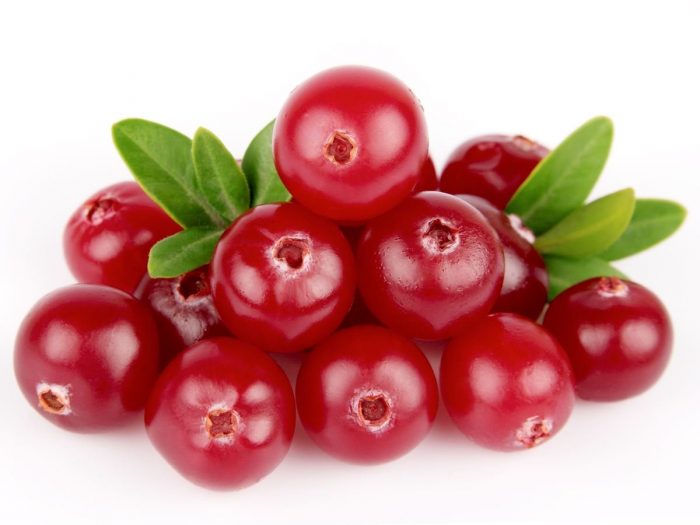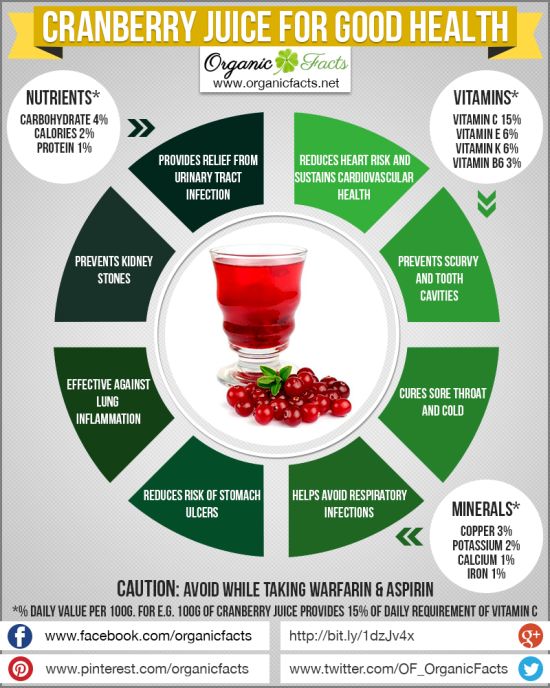The health benefits of cranberry juice include relief from urinary tract infection, respiratory disorders, kidney stones, cancer, and heart disease. It is also beneficial in preventing stomach disorders and diabetes, as well as gum diseases caused by dental plaque. Phytonutrients, which are naturally derived plant compounds, are present in cranberries and have been found to prevent a wide range of health problems.
Cranberries are a versatile fruit and their benefits make them useful in food as well as in medicinal products. The Latin name for cranberry plant is Vaccinium macrocarpon and it is one of the native fruits of North America. Cranberries have a tremendous amount of antioxidant capacity as compared to other fruits and vegetables like broccoli, spinach, and apples. One cup of cranberries offers a total 8983 antioxidant capacity.
Nutritional Value of Cranberry Juice
Cranberry juice is rich in antioxidants, vitamin C and salicylic acid. By containing only 45 calories per cup, cranberry juice fits very well within the dietary guidelines. Cranberry juice also contains 87.13 g water per 100 g. It also provides energy, protein and carbohydrates. In terms of minerals, it contains calcium, magnesium, iron, phosphorus, sodium, potassium and zinc. It also contains vitamins like thiamin, riboflavin, niacin, vitamin B-6, E (alpha tocopherol) and vitamin K (phylloquinone). Cranberries are members of the Ericaceae family, and is native to North America.Health Benefits of Cranberry Juice
Cranberry juice has long been used for curing various illnesses. Some of the health benefits of cranberries include the following.Urinary tract Infections (UTI): Urinary tract infections refer to the existence of certain micro-organisms in the urine that exceed normal levels. These infections can develop in the bladder and cause cystitis, in the kidney to cause renal parenchyma, or in the prostate resulting in bacterial prostatitis. Studies have shown that the cranberry juice contains proanthocyanidins that possess anti-clinging properties, which prevent the bacteria from binding itself to the cells on the walls of the bladder. These compounds prevent these bacteria from multiplying and further and flush them out of the body through urination.
Research shows that drinking cranberry juice regularly can help prevent recurring UTIs in middle-aged women and pregnant women. Regular intake of cranberry juice has also been proven beneficial for patients undergoing other treatments in the hospitals as a guard against the urinary tract diseases. However, cranberry juice is not effective in treating UTIs once you have the infection, and is only a preventative measure.
Antitumor Effects: The anti-tumor efficacy offered by cranberry juice is attributed to the presence of polyphenolic compounds within the fruit. Studies have suggested that regular consumption of cranberry juice inhibits the development and spread of lung, breast, colon, prostate and other cancerous tumors. Cranberry juice contains a high amount of salicylic acid which can help reduce swelling, prevent blood clots, and eliminate tumors.
Cardiovascular Health: Cranberry juice can help lower the risk of heart related ailments and assist in sustaining cardiovascular health. The flavonoids present in cranberries have antioxidant properties and may decrease the threat of atherosclerosis. Atherosclerosis is a disease in which the arteries are narrowed due to the build-up of fat, calcium, and cholesterol found in the blood. This obstructs the flow of oxygen-rich blood to the various parts of the body and may lead to potentially fatal outcomes like heart attacks and strokes. These compounds have been shown to delay and suppress the oxidation of low density lipoprotein (LDL) and beneficially stimulate the blood platelets.

Prevents Tooth Decay: According to new research studies, cranberry juice prevents tooth cavities. Proanthocyanidine, a chemical compound present in cranberries, inhibits the harmful bacteria from clinging to the teeth. These components inhibit acid production and protect the teeth from periodontal disease by preventing the growth of plaque. Good oral hygiene, along with the consumption of cranberries, disrupts the pathogenic mechanism of dental caries and generally makes for good dental health. At the same time, one should watch out for the soaring sugar content and the acidity of some commercially available cranberry juices – natural juice is always better!
Avoid Respiratory Infections: According to conducted studies, cranberry juice helps to inhibit certain strains of the Haemophilus influenza, which is a common cause of ear and respiratory infections in children. The juice inhibits the bacteria’s hair-like structures, inhibiting them from adhering to the surface of the skin.
Prevents Cancer: Cranberry contains proanthocyanidins, which inhibit the growth of various cancer cells. Studies have suggested that diets rich in flavonoids play a fundamental role in reducing the risk of cancer and cancer mortality. Cranberry juice contains anti-carcinogenic components that interfere with the growth of cancer cells, particularly those associated with colon and prostate cancer. According to studies, proanthocyanidins can stop micro-tumors from developing in the blood vessels. Regular consumption of cranberry juice prevents the rapid growth of tumors. Chemicals in cranberries also prevent the multiplication of breast cancer cells.
Strengthens Bones and Teeth: Although cranberry juice is a natural source of calcium, many juice companies add extra calcium to cranberry juice. Natural or otherwise, calcium reduces the risk of getting osteoporosis.
Cures Cold: Fresh cranberry juice is effective at fighting against infections. It cures sore throats and colds.
Good for Obesity: Cranberry juice is rich in organic acids, which have an emulsifying effect on the fat deposits in our body. So, it is good for people who want to shed those extra kilos.
Prevents Kidney Stones: The high amount of acid components in cranberry juice prevents kidney stone formation.
Peptic ulcers: Peptic ulcers are caused by a type of bacteria called Helicobacter pylori or H.pylori. This microorganism attacks the protective layer of the stomach and duodenum, which is the first part of intestine. This may lead to further inflammation of the stomach lining. Foods rich in flavonoids, a category that includes anthocyanins, flavonols and proanthocyanidins, like cranberries, apples and garlic helps reduce the risk of stomach disorders, including stomach ulcers, by inhibiting the growth of H. pylori bacteria. An investigative study performed on a group of patients having that type of stomach disorders showed a 50% advantage over patients that didn’t consume cranberry juice. Therefore, doctors commonly advise the regular intake of cranberry juice to suppress the infection.
Scurvy: Deficiency of vitamin-C in an individual can result in scurvy. Cranberries provide high levels of vitamin-C, which is also vital for the body to make collagen, the main component behind the healthy functioning of tissues.
Lung inflammation: The anti-inflammatory effects of cranberry juice have been proven to be effective against the inflammation caused in the lungs by the influenza virus. A substance called nondialyzable material or NDM present in the cranberries prevents the influenza virus from sticking to the cells and hence preventing a flu infection.

Anti-Aging Benefits: The USDA scientists at the human research center suggest that the wealth of phytonutrients and antioxidants present in cranberries play a vital role in providing protection against the problems that develop with age such as memory loss and lack of coordination. Cranberries have a multitude of therapeutic properties that protect the cells from the damage caused by unstable molecules called free radicals that contribute to aging, thereby making the skin look younger.
Foods: Cranberry fruit extract is used in making various sauces and cranberry juice cocktail. About one liter of juice can be extracted from 1500 grams of fresh cranberries. Cranberry juice cocktails are approximately 30% pure cranberry juice mixed with artificial sweetener or fructose. Dried cranberries can be enjoyed with breakfast cereals or can be added to muffins.
A Word of Caution
Cranberries and cranberry juice offer a variety of health benefits, barring the few exceptions listed below:
Warfarin (Coumadin): Warfarin is an anticoagulant drug that is used as a blood thinner, and it lowers the chances of blood clots occurring in the body. These blood clots can further result in serious conditions like cardiovascular disorders or clots in the legs, lungs, and other parts of the cardiovascular system. There are indications that people who take warfarin should be cautious regarding the intake of cranberry, as they are at a high risk of bleeding. Excess consumption of cranberry juice is not recommended for those people as it may affect the efficacy and safety of warfarin in the body. In such cases, it is always advisable to regularly get your blood tested in order to consume the correct dose of the medication.
Aspirin allergy: Cranberries contain substantial quantities of salicylic acid, which is also present in aspirin. People who need blood thinners and are prescribed aspirin should avoid consuming too much cranberry juice. Intake of cranberries should also be restricted if you are allergic to aspirin.
Kidney stones: Cranberry extracts contain a significant concentration of oxalate and calcium. This amplifies the chances of developing calcium-oxalate stones and uric acid stones in certain people. People who have kidney stones or have a history of kidney stones should consult a medical professional before consuming cranberry supplements or a large amount of cranberry juice. Studies have provided evidence that cranberry juice can raise the level of oxalate in the urine by up to 43%.
Cranberry extracts have been used to deodorize urine in some people who have complications in controlling urination, also known as urinary incontinence. The extracts can prevent the urinary catheters from blocking and speed up the curative process of the membrane around the stomach.
A Final Word on Cranberry Juice: Unsweetened cranberry juice tastes slightly sour, but for medicinal purposes, 2 ounces of cranberry juice diluted in 8 ounces of water is recommended. It is very good for your overall health. Finally, cranberry juice strengthens the immune system and helps to relieve stress. It works well for the skin conditions like acne and can be consumed dried, fresh or frozen.
Enjoy cranberries in any form you like, and also enjoy the wealth of health benefits you can get from this powerful little fruit!
Source:
https://www.organicfacts.net/health-benefits/fruit/health-benefits-of-cranberry-juice.html

